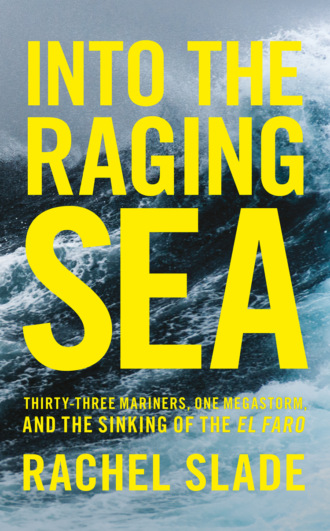
Полная версия
Into the Raging Sea: Thirty-three mariners, one megastorm and the sinking of El Faro
He knew they’d probably feel the aftereffects of the storm and wanted the ship secured for heavy weather. “Take a hard look at some of that cargo down there,” he advised his chief mate. “Delegate the men to look at the lashings as you deem necessary.”
Davidson’s warning about the lashings made the chief mate reconsider what he’d witnessed the day before when the stevedores were loading the trailers and containers onto the ship. He didn’t think they’d secured them properly but didn’t make a big deal out of it. “The longshoreman was doing the lashing wrong and I was trying to help,” Shultz told Davidson. He was the new guy on the ship and felt awkward criticizing their work.
“Go right to the foreman—cut out the middleman,” Davidson advised him. “I do it all the time.”
“They just don’t do the lashing the way it outta be done,” Shultz repeated in frustration. It was his job to make sure loading was done right, but it had all happened so fast, and he hadn’t yet established solid relationships with the workers he was overseeing.
Shifting cargo doesn’t only cause damage, it can break loose and kill a man. It can go right over the deck or wreak havoc in the holds. It can set off a domino effect during heavy seas, throwing the ship over, causing a perilous list. Globally, ships lose an average of about six hundred containers each year to storms, collisions, and groundings. Now that they were at sea, Shultz worried whether they had enough chains to double- or triple-lash if they needed to. If he’d looked at the cargo-securing inventory, he’d know that the vessel was short 170 lashing rods and missing more than a thousand required turnbuckles and twistlocks. Even if he had the equipment on hand, though, trying to lash at sea was miserable—it’s nearly impossible to maneuver around a loaded ship like that to chain things down. The cargo is packed tight, and if something did come loose while you were trying to secure it, you could be crushed. They were too far gone. Hopefully, the chains would hold.
Shultz spent the next several minutes logging alternative routes and waypoints into the ship’s GPS system. He wasn’t completely sure he trusted Joaquin, and he wanted to give the other officers various options if they ran into trouble. The storm had proven an unpredictable and erratic foe; Shultz wanted to work out as many escape routes as he could.
Logging in all those new waypoints (which made a high-pitched beep with each entry), irritated Davidson.
“It’s a good little diversion,” he scoffed at Shultz. “Are you feelin’ comfortable with that, Chief Mate?”
“Better. Yes, sir.”
“You can’t run every single weather pattern,” Davidson barked. His chief mate was already rubbing him the wrong way, and they’d only been up for an hour.
Shultz didn’t want to piss off Davidson. He was brand-new to the ship, new to the captain, and relatively new to the Atlantic. He’d come from shipping for years in the Pacific Northwest and was happy to be on the Puerto Rican run, at least temporarily, closer to Florida where his petite native Brazilian wife and two teens lived. He was a dedicated husband who vigorously embraced his wife’s Catholicism.
Nothing was more sacred aboard a ship than respecting the chain of command. Though he had as much experience as Davidson, Shultz knew to defer to his captain in all things to ingratiate himself to his superior. If he thought that sixty miles from the eye of a major storm didn’t sound right, he kept it to himself. A challenge like that could be viewed as insubordination. Shultz had kids approaching college age. Like everyone else, he had expenses. He needed this job.
Outside in the wild Atlantic, however, there were ominous signs.
At 6:40 a.m., Davidson watched the rising sun set the eastern horizon aflame, reminding him of an old adage. “Look at that red sky over there,” he said to Shultz. “Red in the morning, sailors take warning. That is bright.”
For thousands of years, sailors have viewed crimson skies at dawn as a bad omen. Science backs this up: Red has the longest wavelength in the color spectrum—powerful enough to penetrate the dust and moisture kicked up by an atmospheric event, such as a major storm. Other colors in the rainbow get scattered by thick storm clouds, leaving the sky a blazing scarlet.
Dawn on September 30, 2015, was distorted by a terrific atmospheric event brewing dead ahead of El Faro.
Конец ознакомительного фрагмента.
Текст предоставлен ООО «ЛитРес».
Прочитайте эту книгу целиком, купив полную легальную версию на ЛитРес.
Безопасно оплатить книгу можно банковской картой Visa, MasterCard, Maestro, со счета мобильного телефона, с платежного терминала, в салоне МТС или Связной, через PayPal, WebMoney, Яндекс.Деньги, QIWI Кошелек, бонусными картами или другим удобным Вам способом.




